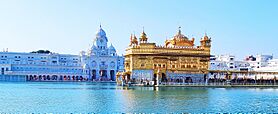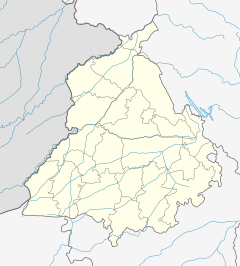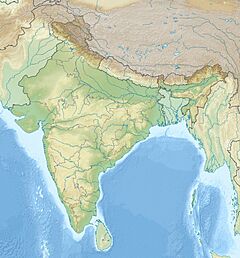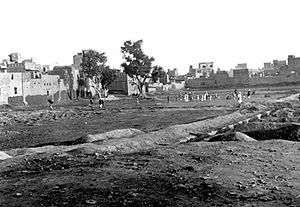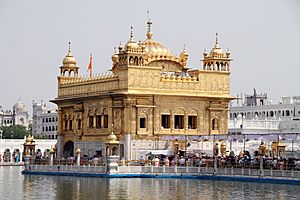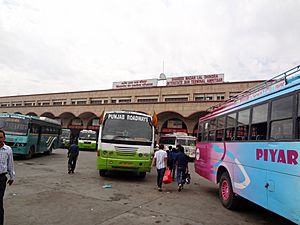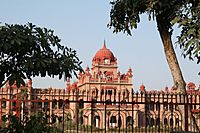Amritsar facts for kids
Quick facts for kids
Amritsar
Amr̥tasara
|
|
|---|---|
|
Gurdwara Baba Atal
Maharaja Ranjit Singh Chowk in Heritage Street
Bhagwan Valmiki Tirath Sthal
Ram Bagh Palace
Gobindgarh Fort
Partition Museum
|
|
| Nicknames:
Nicknames
The Holy City
Ambarsar Sifti Da Ghar Guru Nagari Golden City |
|
| Country | |
| State | |
| District | Amritsar |
| Founded by | Guru Ram Das |
| Government | |
| • Type | Municipality |
| • Body | Amritsar Municipal Corporation |
| Area | |
| • Total | 139 km2 (54 sq mi) |
| Area rank | 2nd in Punjab |
| Population
(2011)
|
|
| • Total | 1,159,227 |
| • Density | 8,340/km2 (21,600/sq mi) |
| • Metro rank | 44th |
| Demonym(s) | Amritsariya, Ambarsariya, Amritsari |
| Time zone | UTC+5:30 (IST) |
| PIN |
143-001
|
| Telephone code | 91 183 XXX XXXX |
| Vehicle registration | PB-01 (commercial vehicles), PB-02 |
Amritsar (Punjabi: [əmːˈɾɪtsəɾ]; ISO: Amr̥tasara), historically also known as Rāmdāspur and colloquially as Ambarsar, is the second-largest city in the Indian state of Punjab, after Ludhiana. Located in the Majha region, it is a major cultural, transportation and economic centre. The city is the administrative headquarters of the Amritsar district. It is situated 217 km (135 mi) north-west of Chandigarh, and 455 km (283 mi) north-west of New Delhi. It is 28 km (17.4 mi) from the India-Pakistan border, and 47 km (29 mi) north-east of Lahore, Pakistan.
According to the 2011 census, the city had a population of 1,132,383. It is one of the ten municipal corporations in the state; Karamjit Singh Rintu is serving as the mayor of the city. According to the United Nations, as of 2018, Amritsar is the second-most populous city in Punjab and the most populous metropolitan region in the state, with a population of roughly 2 million. Amritsar is the centre of the Amritsar Metropolitan Region.
Amritsar is the economic capital of Punjab. It is a major tourist centre with nearly a hundred thousand daily visitors. The city has been chosen as one of the heritage cities for the Heritage City Development and Augmentation Yojana (HRIDAY) program of the Government of India. It is home of the Golden Temple, one of Sikhism religion's most spiritually significant and most-visited gurudwaras. The city is also known for Amritsari food, and wooden chessboards and the chess pieces manufacturing industry.
Contents
Mythology
The Bhagwan Valmiki Tirath Sthal situated at Amritsar is believed to be the ashram site of Maharishi Valmiki, the writer of the Ramayana. As per the Ramayana, Sita gave birth to Lava and Kusha, sons of Rama at Ramtirath ashram. Numerous people visit Ramtirath Temple, Located 12 Km west of Amritsar on Chogawan road, dates back to the period of Ramayana, Rishi Valmiki's hermitage. at the annual fair. The nearby cities Lahore and Kasur were believed to be founded by Lava and Kusha, respectively. It is believed that during the ashvamedha yajna by Rama, Lava and Kusha caught the ritual horse and tied Hanuman to a tree near to today's Durgiana Temple.
History
Founding of Amritsar city
In the Sikh tradition, Guru Ram Das, the fourth Sikh guru, is credited with founding the holy city of Amritsar. Two versions of stories exist regarding the land where Guru Ram Das settled. In one, based on a Gazetteer record, the land was purchased, with Sikh donations, for 700 rupees from the owners of the village of Tung.
According to historical Sikh records, the site was chosen by Guru Amar Das and called Guru Da Chakk. The latter guru had asked Ram Das to find land to start a new town, and to create a man-made pool as its central point. After the coronation Guru Ram Das in 1574, who faced hostile opposition from the sons of Guru Amar Das, he founded the town; it was named after him as "Ramdaspur". He first completed the pool, and built his new official Guru centre and home next to it. He invited merchants and artisans from other parts of India to settle into the new town with him. The town expanded during the time of Guru Arjan Dev, financed by donations and constructed by volunteers. town grew to become the city of Amritsar. After the son of Guru Amar Das built the gurdwara Harmandir Sahib, the pool area developed further as a temple complex. In 1604 Amar Das's son installed the scripture of Sikhism inside the new temple.
The period and achievements of construction between 1574 and 1604 are described in Mahima Prakash Vartak, a semi-historical Sikh hagiographic text likely composed in 1741. It is the earliest known document dealing with the lives of all the ten Gurus.
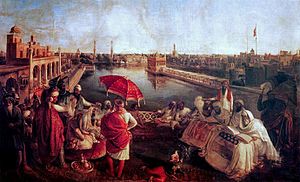
In 1762 and 1766–1767, Ahmad Shah of the Durrani Empire invaded the Sikh Confederacy. He besieged Amritsar, massacred the populace, and destroyed the city.
Old walled city
During the reign of the Sikh Empire, in 1822 Maharaja Ranjit Singh fortified the city, starting from a wall at Katra Maha Singh area.
Among the Katras (fortified residential societies) constructed by Maharaja Ranjit Singh within the city were the following:
- Katra Moti Ram
- Katra Kanwar Kharak Singh (also known as 'Katra Nikkai')
- Katra Fateh Singh Kallianwala
- Katra Ahluwalia
Later, Sher Singh continued with construction of the city wall, adding twelve gates. He also had built a fort named Dhoor Kot; its fortification were yards broad and 7 yards high. The circumference of the walled city was around five miles. The twelve gates constructed during this era were known as (including later renamings):
- Lahori Darwaza (Lahori Gate)
- Khazana Darwaja (Khazana Gate)
- Deori Hakiman (Gate Hakeema/Darwaza Hakeema Wala)
- Gilwali Darwaza – no longer extant
- Darwaza Rangar Nanglian (Gate Bhagatawala) – no longer extant
- Darwaza Ramgarhian (Chattiwind Gate) – later restored
- Darwaza Ahluwalia (Darwaza Gheo Mandi) – was no longer extant but has since been restored
- Doburji Darwaza (Sultanwind Gate or Delhi Darwaza)
- Deorhi Kalan
- Darwaza Rambagh
- Deorhi Shazada (Hathi Darwaza/Darwaza Sehzada)
- Darwaza Lohgarh – no longer extant
When the British annexed Punjab in 1849, Amritsar was a walled city. The British built a thirteenth gate in 1866 known as Hall Gate, Neighborhood in Amritsar, Punjab.
The British rulers would later demolish some of the walls and gates or reconstruct some. An entire new wall of the city was completed in 1885. Many surviving gates have since been renamed and no longer bear their mid-19th century names, while others have since been demolished.
Jallianwala Bagh massacre
The Jallianwala Bagh massacre, involving the killings of hundreds of Indian civilians on the orders of British Colonel Reginald Edward Harry Dyer, took place on 13 April 1919 in the heart of Amritsar, the holiest city of the Sikhs, on a day sacred to them as the birth anniversary of the Khalsa (Vaisakhi day).
In Punjab, during World War I (1914–18), there was considerable social unrest, particularly among the Sikhs. First, they opposed the demolition of a boundary wall of Gurdwara Rakab Ganj, a historic gurdwara near Parliament House in New Delhi. Later, they were disturbed about the activities and trials of the Ghadarites, almost all of whom were Sikhs. In India as a whole, political activity had arisen during the strains of war. Two leaders had emerged: Mahatma Gandhi (1869–1948), who after a period of struggle as a young man against the British in South Africa, and had returned to India in January 1915 to work there for change; and Annie Besant (1847–1933), head of the Theosophical Society of India. On 11 April 1916 she established the Home Rule League with the goal of autonomy for India. In December 1916, the Indian National Congress, at its annual session held at Lucknow, passed a resolution asking the king to issue a proclamation announcing that it is the "aim and intention of British policy to confer self-government on India at an early date".
On 10 April 1919, Satya Pal and Saifuddin Kitchlew, two popular proponents of the Satyagraha movement led by Gandhi, were called to the deputy commissioner's residence. There they were arrested and transported by car to [Dharamsetla]], a hill town, now in Himachal Pradesh. A general strike arose in response in Amritsar. Excited groups of citizens soon merged into a crowd of about 50,000 marching to protest these arrests to the deputy commissioner. The crowd, however, was stopped by British colonial forces and fired upon near the railway foot-bridge. The official version reported that the number of casualties were 12 dead and between 20 and 30 wounded. Based on evidence presented to an inquiry of the Indian National Congress, fatalities were reported as between 20 and 30.
Three days later, on 13 April, the traditional festival of Baisakhi, thousands of unarmed Hindus, Sikhs and Muslims gathered in the Jallianwala Bagh. An hour after the meeting began as scheduled at 16:30, Dyer arrived with a group of sixty-five Gurkha soldiers (from the 9th Gorkha Rifles) and twenty-five Baluchi soldiers (from the 59th Scinde Rifles). Without warning the crowd to disperse, Dyer blocked the main exits from the Bagh and ordered his troops to begin shooting toward the densest sections of the crowd; the firing continued for approximately ten minutes. A British government inquiry into the massacre placed the death toll at 379. The Indian National Congress, on the other hand, estimated that approximately 1,000 people were killed.
Operation Blue Star
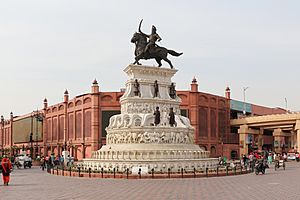
Amritsar was a center of unrest in the late 20th century. In the 1980s, Sikh militants occupied the Golden Temple there. Prime Minister of India, Indira Gandhi, ordered Operation Blue Star (1 – 6 June 1984), an Indian military operation to remove the militants from the temple. The operation was carried out by Indian army troops equipped with tanks and armoured vehicles. While militarily successful, the operation aroused immense controversy. The government's justification for the timing and style of the attack are hotly debated. India Today magazine has ranked Operation Blue Star as among the Top 10 Political Disgraces in India.
Official reports put the number of deaths among the Indian army at 83, with 493 civilians and Sikh militants killed. While independent estimates place the numbers upwards of 5,000 people, a majority of them pilgrims, including women and children. In addition, the CBI is considered responsible for seizing historical artefacts and manuscripts in the Sikh Reference Library before burning it down. Four months after the operation, on 31 October 1984, Indira Gandhi was assassinated by two of her Sikh bodyguards in what is viewed as an act of vengeance. Following her assassination, more than 17,000 Sikhs were killed in the 1984 anti-Sikh riots.
Geography
Amritsar is located at 31°38′N 74°52′E / 31.63°N 74.87°E with an average elevation of 234 metres (768 ft) in the Majha region of the state of Punjab in North India and lies about 15 miles (24 km) east of the border with Pakistan. Administrative towns includes Ajnala, Attari, Beas, Budha Theh, Chheharta Sahib, Jandiala Guru, Majitha, Rajasansi, Ramdass, Rayya, Verka Town and Baba Bakala.
Climate
Typically for Northwestern India, Amritsar has a hot semi-arid climate (Köppen BSh) bordering on a monsoon-influenced humid subtropical climate (Cwa). Temperatures in Amritsar usually range from −1 to 45 °C (30 to 113 °F). It experiences four primary seasons: winter (December to March), when temperatures can drop to −1 °C (30 °F); summer (April to June), when temperatures can reach 45 °C (113 °F); monsoon (July to September); and post-monsoon (October to November). Annual rainfall is about 726.0 millimetres (28.6 in). The lowest recorded temperature is −3.6 °C (25.5 °F), was recorded on 9 December 1996 and the highest temperature, 48.0 °C (118.4 °F), was recorded on 23 May 2013. The official weather station for the city is the civil aerodrome at Rajasansi. Weather records here date back to 15 November 1947.
| Month | Jan | Feb | Mar | Apr | May | Jun | Jul | Aug | Sep | Oct | Nov | Dec | Year |
|---|---|---|---|---|---|---|---|---|---|---|---|---|---|
| Record high °C (°F) | 26.8 (80.2) |
32.2 (90.0) |
36.2 (97.2) |
44.1 (111.4) |
48.0 (118.4) |
47.8 (118.0) |
45.6 (114.1) |
40.7 (105.3) |
40.6 (105.1) |
38.3 (100.9) |
34.2 (93.6) |
28.5 (83.3) |
48.0 (118.4) |
| Mean maximum °C (°F) | 22.7 (72.9) |
26.1 (79.0) |
32.4 (90.3) |
40.6 (105.1) |
44.5 (112.1) |
44.6 (112.3) |
39.8 (103.6) |
37.0 (98.6) |
36.4 (97.5) |
35.3 (95.5) |
30.4 (86.7) |
25.2 (77.4) |
45.6 (114.1) |
| Mean daily maximum °C (°F) | 17.7 (63.9) |
21.7 (71.1) |
27.0 (80.6) |
34.4 (93.9) |
39.4 (102.9) |
38.9 (102.0) |
35.0 (95.0) |
34.1 (93.4) |
33.9 (93.0) |
32.0 (89.6) |
27.0 (80.6) |
20.9 (69.6) |
30.1 (86.2) |
| Daily mean °C (°F) | 11.0 (51.8) |
14.4 (57.9) |
19.0 (66.2) |
25.4 (77.7) |
30.7 (87.3) |
31.8 (89.2) |
30.3 (86.5) |
29.7 (85.5) |
28.2 (82.8) |
24.1 (75.4) |
18.1 (64.6) |
12.6 (54.7) |
22.9 (73.2) |
| Mean daily minimum °C (°F) | 3.8 (38.8) |
6.7 (44.1) |
11.2 (52.2) |
16.6 (61.9) |
21.9 (71.4) |
24.7 (76.5) |
25.7 (78.3) |
25.3 (77.5) |
22.7 (72.9) |
16.4 (61.5) |
9.4 (48.9) |
4.6 (40.3) |
15.7 (60.3) |
| Mean minimum °C (°F) | −0.3 (31.5) |
2.2 (36.0) |
6.1 (43.0) |
10.9 (51.6) |
16.6 (61.9) |
19.7 (67.5) |
21.8 (71.2) |
21.7 (71.1) |
18.5 (65.3) |
11.8 (53.2) |
5.2 (41.4) |
0.5 (32.9) |
−0.7 (30.7) |
| Record low °C (°F) | −2.9 (26.8) |
−2.6 (27.3) |
2.0 (35.6) |
6.4 (43.5) |
9.6 (49.3) |
15.6 (60.1) |
18.2 (64.8) |
18.8 (65.8) |
13.0 (55.4) |
7.3 (45.1) |
−0.6 (30.9) |
−3.6 (25.5) |
−3.6 (25.5) |
| Average rainfall mm (inches) | 27.1 (1.07) |
39.8 (1.57) |
32.6 (1.28) |
21.9 (0.86) |
20.8 (0.82) |
80.9 (3.19) |
181.6 (7.15) |
168.9 (6.65) |
90.7 (3.57) |
12.3 (0.48) |
5.8 (0.23) |
6.8 (0.27) |
689.2 (27.13) |
| Average rainy days | 2.1 | 3.1 | 2.4 | 1.9 | 2.0 | 4.8 | 8.1 | 7.0 | 3.7 | 1.0 | 0.6 | 0.8 | 37.4 |
| Average relative humidity (%) (at 17:30 IST) | 68 | 58 | 50 | 32 | 26 | 40 | 65 | 70 | 64 | 52 | 53 | 63 | 53 |
| Average dew point °C (°F) | 7.0 (44.6) |
10.0 (50.0) |
13.3 (55.9) |
14.0 (57.2) |
15.0 (59.0) |
19.5 (67.1) |
25.0 (77.0) |
25.6 (78.1) |
23.5 (74.3) |
18.3 (64.9) |
12.0 (53.6) |
8.0 (46.4) |
15.9 (60.7) |
| Mean monthly sunshine hours | 181.7 | 192.7 | 219.4 | 265.0 | 294.7 | 269.0 | 215.5 | 227.7 | 240.8 | 253.2 | 220.1 | 182.2 | 2,762 |
| Average ultraviolet index | 2 | 4 | 6 | 7 | 8 | 9 | 7 | 6 | 5 | 5 | 4 | 2 | 5 |
| Source 1: India Meteorological Department Time and Date (dewpoints, 2005-2015) | |||||||||||||
| Source 2: NOAA (sun 1971–1990) Tokyo Climate Center (mean temperatures 1991–2020); Weather Atlas | |||||||||||||
Amritsar has been ranked 39th best “National Clean Air City” (under Category 1 >10L Population cities) in India according to 'Swachh Vayu Survekshan 2024 Results'
Demographics
| Historical population | ||
|---|---|---|
| Year | Pop. | ±% |
| 1901 | 162,429 | — |
| 1911 | 152,756 | −6.0% |
| 1921 | 160,218 | +4.9% |
| 1931 | 264,840 | +65.3% |
| 1941 | 391,010 | +47.6% |
| 1951 | 336,114 | −14.0% |
| 1961 | 390,055 | +16.0% |
| 1971 | 454,805 | +16.6% |
| 1981 | 594,844 | +30.8% |
| 1991 | 708,835 | +19.2% |
| 2001 | 979,801 | +38.2% |
| 2011 | 1,159,227 | +18.3% |
As of the 2011 census, Amritsar municipality had a population of 1,159,227. The municipality had a sex ratio of 884 females per 1,000 males and 119,592 (10.32%) of the population were under six years old, with the child sex ratio being 826 females per 1000 males. Literacy was 83.81%; male literacy was 86.52% and female literacy was 80.76%. The scheduled caste population is 21.76%.
Religion
| Religion in Amritsar City (2011) | ||||
|---|---|---|---|---|
| Religion | Percent | |||
| Hinduism | 49.36% | |||
| Sikhism | 48.00% | |||
| Christianity | 1.23% | |||
| Islam | 0.51% | |||
| Other or not stated | 0.90% | |||
According to 2011 Census of India, Hinduism is the main religion of the Amritsar city at 49.36% of the population, followed by Sikhism (48.00%), Christianity (1.23%), and Islam (0.51%). Around 0.9% of the population of the city stated 'No Particular Religion' or other religion.
Amritsar is the holiest city in Sikhism and about 30 million people visit it each year for pilgrimage.
| Religious group |
1868 | 1881 | 1891 | 1901 | 1911 | 1921 | 1931 | 1941 | 2011 | |||||||||
|---|---|---|---|---|---|---|---|---|---|---|---|---|---|---|---|---|---|---|
| Pop. | % | Pop. | % | Pop. | % | Pop. | % | Pop. | % | Pop. | % | Pop. | % | Pop. | % | Pop. | % | |
| Islam |
61,193 | 45.69% | 75,891 | 49.96% | 63,366 | 46.33% | 77,795 | 47.89% | 71,851 | 47.04% | 71,180 | 44.43% | 132,362 | 49.98% | 184,055 | 47.07% | 5,862 | 0.51% |
| Hinduism |
49,115 | 36.67% | 61,274 | 40.34% | 56,652 | 41.42% | 65,117 | 40.09% | 58,720 | 38.44% | 65,313 | 40.77% | 98,001 | 37% | 144,522 | 36.96% | 572,189 | 49.36% |
| Sikhism |
19,267 | 14.39% | 13,876 | 9.14% | 15,751 | 11.52% | 17,860 | 11% | 20,357 | 13.33% | 21,478 | 13.41% | 32,009 | 12.09% | 58,779 | 15.03% | 556,431 | 48% |
| Christianity |
130 | 0.1% | N/A | N/A | 848 | 0.62% | 1,104 | 0.68% | 1,128 | 0.74% | 1,446 | 0.9% | 1,819 | 0.69% | 2,611 | 0.67% | 14,280 | 1.23% |
| Buddhism |
0 | 0% | N/A | N/A | 0 | 0% | 0 | 0% | 0 | 0% | 5 | 0% | 0 | 0% | N/A | N/A | 773 | 0.07% |
| Jainism |
N/A | N/A | 9 | 0.01% | 143 | 0.1% | 532 | 0.33% | 652 | 0.43% | 738 | 0.46% | 604 | 0.23% | 974 | 0.25% | 1,143 | 0.1% |
| Zoroastrianism |
N/A | N/A | N/A | N/A | 5 | 0% | 19 | 0.01% | 48 | 0.03% | 58 | 0.04% | 41 | 0.02% | N/A | N/A | N/A | N/A |
| Judaism |
N/A | N/A | N/A | N/A | 0 | 0% | N/A | N/A | 0 | 0% | 0 | 0% | 4 | 0% | N/A | N/A | N/A | N/A |
| Others | 4,220 | 3.15% | 846 | 0.56% | 1 | 0% | 2 | 0% | 0 | 0% | 0 | 0% | 0 | 0% | 79 | 0.02% | 8,549 | 0.74% |
| Total population | 133,925 | 100% | 151,896 | 100% | 136,766 | 100% | 162,429 | 100% | 152,756 | 100% | 160,218 | 100% | 264,840 | 100% | 391,010 | 100% | 1,159,227 | 100% |
At the time of the 2011 census, 91.12% of the population spoke Punjabi and 7.90% Hindi as their first language.
Tourism
- Golden Temple and Heritage Street
- Durgiana Mandir and Bada Hanuman Mandir
- Mata Lal Devi Mandir, Model Town
- Shri Ram Tirath and Valmiki Tirath
- Shivala Bagh Bhaiyan
- Punjab State War Heroes' Memorial & Museum
- Sadda Pind
- Urban Haat Food Street
- Gobindgarh Fort
- Ram Bagh Palace and
- Maharaja Ranjit Singh Museum
- Wagah border
- Gurudwara Shaheed Ganj Sahib
- Partition Museum
- Jallianwala Bagh
- Pul Kanjri
- VR Ambarsar, Circular Road
- Mall of Amritsar, near Hyatt
- Jang-e-Azadi Memorial near Kartarpur, India
Economy
Amritsar is the second-largest city and district of Punjab. It is also one of the fastest-growing cities of Punjab. In the mid-1980s the city was famous for its textile industry. Amritsar's trade and industry faced a blow during militancy period in 1980s, but there are still many textile mills, knitting units and embroidery factories functional in the city. It is famous for its pashmina shawls, woolen clothes, blankets, etc. Among handicrafts, the craft of the Thatheras of Jandiala Guru in Amritsar district got enlisted on UNESCO's List of Intangible Cultural Heritage in 2014, and the effort to revive this craft under the umbrella of Project Virasat is among India's biggest government-sponsored craft revival programs. Tourism and hospitality have recently become the backbone of local economy due to heavy tourist arrivals. Hundreds of small and some large hotels have sprung up to cater to the increased tourist inflow. Restaurants, taxi operators, local shopkeepers have all benefited from the tourist boom.
Transport
Air
Amritsar hosts Sri Guru Ram Das Ji International Airport. The airport is connected to other parts of India and other countries with direct international flights to cities and is the 12th busiest airport in the country in terms of international traffic. It serves Amritsar and several other districts in Punjab and neighbouring states.
Rail
Amritsar Junction railway station is the main station serving Amritsar. It is the busiest railway station in Indian state of Punjab and one of the highest revenue-generating station of Northern Railways. Due to high traffic at the Amritsar Junction railway station]], Indian Railways has planned to develop two satellite stations-Chheharta and Bhagtanwala, in order to decongest traffic at this station. As many as 6 trains would be shifted to Chheharta railway station in the first phase. The Indian Railway Stations Development Corporation has also planned to make the Amritsar Junction railway station a world-class railway station on lines of the international airport based on PPP model. The project has received an overwhelming response with bids from 7 private firms, including GMR.
Road
Amritsar is located on the historic Grand Trunk Road (G.T. Road), also known as NH 1 now renumbered as National Highway 3. An expressway by name of Delhi–Amritsar–Katra Expressway at the cost of ₹25,000 crore is approved under Bharatmala scheme which will cut the travel time from Amritsar to New Delhi by road from current 8 hours, to 4 hours. Another expressway, called Amritsar–Jamnagar Expressway is under construction which will connect Amritsar to Jamnagar in Gujarat. Additionally, NH 54 (Old NH15), NH 354 and NH 503A connect Amritsar to other parts of state and rest of India. A ring road will also be built surrounding all 4 sides of Amritsar
₹ 450,000,000 is being spent to expand the Amritsar-Jalandhar stretch of G.T. Road to four lanes. In 2010, elevated road with four lanes connected to the National highway for better access to the Golden Temple has been started.
Amritsar MetroBus
Amritsar has a bus rapid transit service, the Amritsar Metrobus which was launched on 28 January 2019. 93 fully air-conditioned Tata Marcopolo buses are used for the service connecting places like
- Golden Temple
- Jallianwala Bagh
- Guru Nanak Dev University
- Golden Gate
- India Gate, Amritsar
- Durgiana Temple
- Khalsa College
Sister Cities
Following cities are Sister Cities of Amritsar:
- Bakersfield, California, United States
- Sandwell, West Midlands, England, United Kingdom
- Thetford, Norfolk, England, United Kingdom
Educational institutions
- BBK DAV College for Women
- D.A.V College
- D.A.V Public School
- Delhi Public School
- Government Medical College
- Guru Nanak Dev University
- Khalsa College
- Khalsa College of Law
- Indian Institute of Management
- Spring Dale Senior School
Medical facilities
- Dr. Vidyasagar Institute of Mental Health, a government mental hospital
- Government Medical College
- Sri Guru Ram Das University of Health Sciences
See also
 In Spanish: Amritsar para niños
In Spanish: Amritsar para niños


